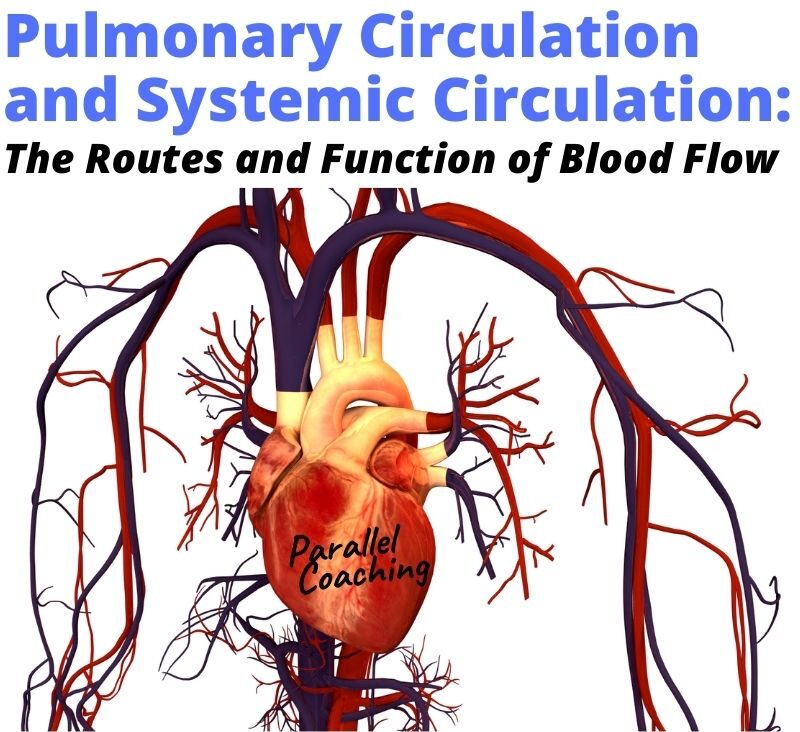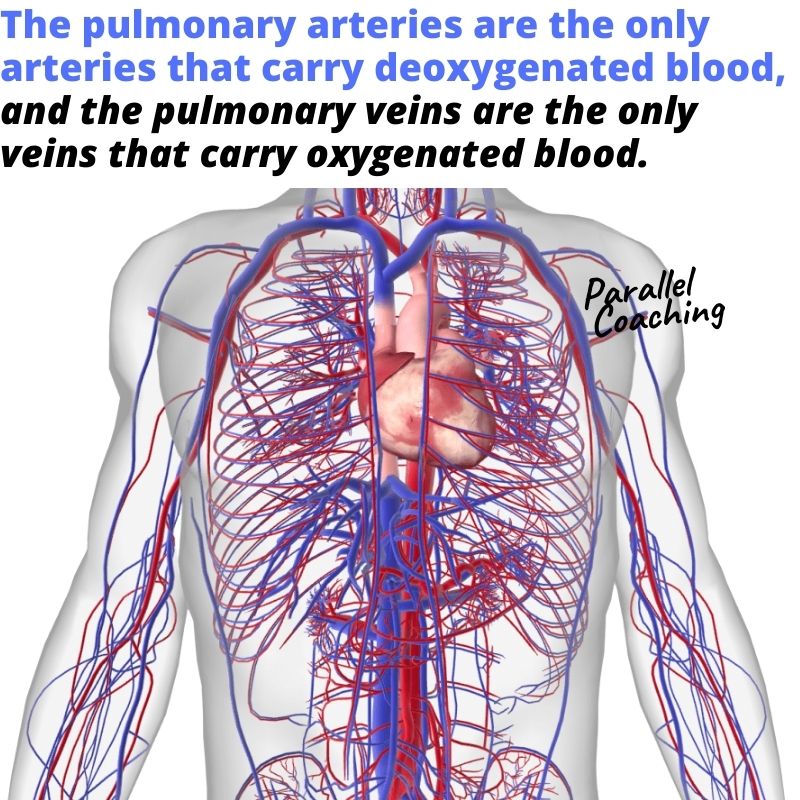In today’s blog, we’ll unpick this tough mock question and deep dive into the pulmonary circulatory system, as well as the systemic circulation and understanding the flow of blood through the body.
This mock question tests your knowledge for Module 1: The Heart & Circulatory System.
Module 1 is the same for both level 2 and 3 anatomy and physiology exams. You can learn what the other 7 modules are below.
Let’s jump into today’s mock question.
First off, let’s extract the keywords.
- Forms
- Pulmonary circulatory system
It’s crucial you extract the keywords. This allows you to reword the question and add relevant definitions, meaning you can be 100% sure what is being asked of you. It also gives you more certainty to pick the right answer and know you are right.
Next… let’s add some simple definitions to our keywords.
“Forms” is a noun.
A noun is a word that refers to a thing such as a cat, or a place, or a person.
“Forms” can also is also defined as a particular way in which a thing exists or appears.
With this in mind… we are looking for a particular location or how the pulmonary circulation appears.
The next keywords we extracted was: “Pulmonary circulatory system”
Before we deep dive into the Pulmonary circulatory system. Let’s take a 10,000ft view back and explore circulation first.
The circulatory system consists of the heart, arteries, and veins. Together these transport blood throughout the body. Blood must always circulate to sustain life.
Blood carries oxygen from the air we breathe to every cell in our body.
The ‘HEART’ is at the center point of circulation as it pumps oxygenated blood around the body. The heart also pumps deoxygenated blood to the lungs.
With that said,
there are two types of circulation.
- Pulmonary Circulation
- Systemic Circulation

The above mock question is asking about the Former.
Pulmonary circulation moves blood between the heart and the lungs and back to the heart.
We can call this the pulmonary loop or pulmonary circulation.
We start in the right ventricle. This heart chamber is on the right side of the heart. This chamber’s role is to pump deoxygenated blood through the pulmonary valve.
Here the pulmonary artery or pulmonary trunk splits into two. The right and left pulmonary arteries
These arteries transport the deoxygenated blood to arterioles. Then to the capillary beds in the lungs.
There, carbon dioxide is released and oxygen is absorbed.

[We could say the Circulatory System works in tandem with the respiratory system]. Which is a separate module for your exam at level 2.
Oxygenated blood then passes from the capillary beds through venules into the pulmonary veins.
The pulmonary veins transport oxygenated blood to the left atrium of the heart.
◾️ Pulmonary arteries are the only arteries that carry deoxygenated blood.
◾️ And the pulmonary veins are the only veins that carry oxygenated blood.

We established above the circulatory and respiratory systems work together.
In essence to sustain the body with oxygen and to remove carbon dioxide. Specifically, pulmonary circulation facilitates the process of external respiration.
Where deoxygenated blood flows to the lungs from the right side of the heart. It’s in the capillary beds of the lungs where gaseous exchange takes place.
In short… carbon dioxide is released and exhaled. At the same time, oxygen from tiny air sacs (the alveoli) is absorbed.
Before we tackle the mock question and answer it.
Let’s also have a brief overview of “systemic circulation”.
This is another loop called the systemic loop or systemic circulation.
Here Oxygenated blood is pumped from the left ventricle of the heart through the aorta. The aorta is the largest artery in the body. Blood moves from the aorta through the systemic arteries. Passes through to arterioles and capillary beds that supply body tissues.
Here, oxygen and nutrients are released and carbon dioxide and other waste substances are absorbed. Deoxygenated blood then moves from the capillary beds through venules into the systemic veins.
The systemic veins (venus return) feed into the inferior and superior venae cavae, the largest veins in the body. The venae cavae flow deoxygenated blood to the right atrium of the heart.
Now we have explored pulmonary and systemic circulation, let’s review the mock question.
Which of the following forms part of the pulmonary circulatory system?
There are four possible answers below the mock question.
We know we are searching for a specific location or area of the pulmonary system.
Based on our deep dive of knowledge we know it can’t be:
- A. The Aorta forms an early stage of the systemic system.
- C. forms one of the last stages of the systemic system as well. The vena cava assist in venous return and feeds deoxygenated blood to the right atria.
- D. the left Ventricle forms part of the systemic system. The left ventricle forcefully pumps blood through the aorta.
- Meaning the answer must be B. The Right Ventricle.
We established above the right ventricle was the starting point for the pulmonary circulatory system. It’s absolutely vital you extract the keywords when practicing mock questions. The keywords allow you, deep-dive, into specific topics.
It’s no good just using mock questions to learn and revise.
Stand-alone mock questions don’t give you any further knowledge about a topic.
Mock questions are a great way to test your knowledge once you have learned a particular topic. This way you can learn the wording and style of questions ready for your exam
Test your knowledge with today’s body in motion mock questions:
[NOTE: The answers are below the 3rd questions]
Q1: Which part of the circulatory system provides blood flow to and from the lungs?
A. Systemic
B. Coronary
C. Pulmonary
D. Oxygenated
Q2: What is the name of the large blood vessel that takes oxygenated blood away from the heart to the body?
A. Pulmonary artery
B. Aorta
C. Pulmonary Vein
D. Vena Cava
Q3: The Vena Cava is part of which circulation system?
A. Systemic
B. Coronary
C. Pulmonary
D. Oxygenated
Answers to the mock questions are :
Question 1= C, Question 2 = B, Question 3 = A
Download Hundreds of Mock Questions For Free
If you want more mock questions like this, then you can download more Free Mock Questions: DOWNLOAD NOW
Need More Help with your Level 3 Anatomy Revision?
or Trainee FITPROS Taking Their L3 Anatomy & Physiology Exam.
Learn, Revise & Pass Your Level 3 Anatomy & Physiology Exam In Under 10-hours
(Without Having To Spend Hours Revising Or Feeling Overwhelmed)
If you want to get your revision structured, learn everything you need to know and feel confident on exam day, then click the link below:

Dedicated to More
Hayley “pulmonary circulatory system” Bergman
Parallel Coaching
P.S. You can also find us on the following platforms:
Instagram: Follow Now
Facebook: Like Our Page
Twitter: Tweet Us
YouTube: Subscribe Here
More Mock Question Blogs: HERE

